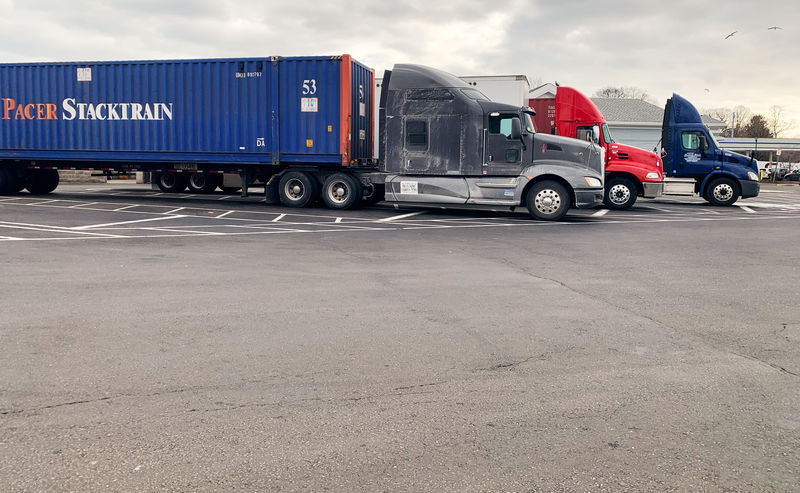By Stephanie Kelly and Jessica Resnick-Ault
(Reuters) - At a truck stop in Ridgefield, New Jersey, driver Paul Richards reviews a notebook where he tracks miles driven and what he is hauling. His paycheck is down about 25 percent from the same period a year ago, and his weekly miles have dropped as well.
"This hasn't been a very good week," said Richards, who carries building materials and recycled goods through the U.S. Northeast. "Last week wasn't, either."
Across the United States, drivers, regional operators and industry officials say the $700 billion (£536.7 billion) U.S. trucking sector slipped in late 2018, with the fall continuing into this year.
While the decline in freight rates and hauling does not suggest the United States is headed into a recession, that softness is consistent with slippage in the economy as a whole.
The effects have been uneven nationwide, with weaker orders and miles in the U.S. Midwest and Southeast than on the West Coast, economists and regional officials said.
Trucking accounts for 70 percent of U.S. shipment tonnage, and is key to supplying the manufacturing, construction and retail sectors, all of which showed sluggishness in the first quarter. The most common factors for the decline include the U.S.-China trade war and weakness in the Farm Belt.
An ACT Research index of truck carrier volumes that surveys about 60 fleets crossed into negative territory in November for the first time since July 2016. It briefly returned to positive territory in January but dipped again in February. It matches forecasts for a soft first quarter for U.S. gross domestic product, which is expected to come in at 1.8 percent growth, according to Reuters polling.
"Clearly, the economy is slowing down," Kenny Vieth, president of ACT Research, said in a recent interview. "When the economy moderates, the trucking industry can be exceptionally worse than the overall economy because of the deep cyclical trend that characterizes the industry."
To be sure, another indicator, the American Trucking Associations tonnage index, is at a healthy level at 117.4, still far above recession-era levels between 2008 and 2012, when it remained below 90.
(GRAPHIC: Truck tonnage and U.S. real GDP: https://tmsnrt.rs/2OjFgls)
REGIONAL SOFTNESS
The industry's softness is not uniform nationwide. Reuters spoke to 47 out of 50 state trucking associations, and of those that responded, 16, including Illinois, Wisconsin, Ohio and Tennessee, said activity had slowed. Another 16 said there was little change, and the rest could not say one way or another.
Shipments in the Midwestern and Southeastern United States have been hit harder than other regions, according to Bobby Holland, vice president and director of Minneapolis-based U.S. Bank Freight Data Solutions. In the Midwest, export tariffs on crops have hurt agricultural sales, and auto production is also moderating, he said.
Neal Kedzie, president of the Wisconsin Motor Carriers Association, said activity started to slow at the end of 2018. Brokers had been connecting trucking companies known as carriers with requests from those who needed to haul freight. Now, though, carriers are starting to reach out to brokers to find loads.
"Carriers are having to do more searching on their own versus the brokers, who (before) had so much to deliver that they couldn't find enough trucks," Kedzie said.
Northeast shipments were strong last year, U.S. Bank said, but state officials in Maine, Connecticut and Rhode Island all told Reuters that early 2019 has been weaker.
A year ago, Larry Hobson was driving 14 hours a day hauling refrigerated food from Tennessee to New England. Now he is working eight or nine hours a day, and his paycheck has dropped by about $1,000 a week because of the decrease.
"I am a lot less busy," he said at a service centre in Darien, Connecticut.
(GRAPHIC: regional shipment growth: (https://tmsnrt.rs/2NRPt8O)
PROFIT WARNINGS
Spot total rates for freight have slumped as well, averaging $1.85 per mile in March, according to DAT Solutions, a freight exchange company. That's the lowest seasonally since 2017.
That weakness is starting to show up in company results. In mid-March, Chattanooga, Tennessee-based Covenant Transportation Group Inc warned of weak first-quarter results, saying average freight revenue per tractor was down 5 percent in early 2019 from the year-ago period, with average miles down more than 11 percent.
"The truckload freight environment has been weaker this year from late January through mid-March," CEO David Parker said in a statement last month. Covenant shares are down more than 20 percent in the last six months.
Analysts have lowered quarterly per-share estimates for J.B. Hunt Transport Services Inc, Covenant and service company Knight-Swift Transportation Holdings Inc by 9 percent, 40 percent and 5 percent, respectively, according to Refinitiv Eikon data.

"There's no doubt that we have been seeing a deceleration in volumes," said Bob Costello, chief economist for the American Trucking Associations (ATA). "This is an indication that the economy is decelerating."